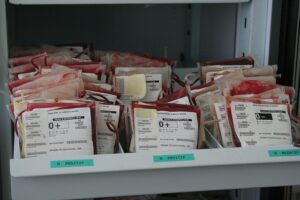Call for your appointment today 914-666-4665 | Mt. Kisco, New York

The numbers of individuals in the US who are unaware they are infected with Babesia could be significant. At least 300,000 people are diagnosed with Lyme disease every year in the US. And up to 40% of those with Lyme disease in the northeast have been found to also be infected with Babesia. [2]
In fact, Linden and colleagues from the Wadsworth Center, New York State Department of Health found, “The incidence of both community-acquired babesiosis and TTB [transfusion-transmitted babesiosis] increased significantly during the 12-year study period.” And, “The geographic range of both ticks and tickborne infections also expanded.” [1]

In 2004, there were 91 cases of community-acquired Babesia, compared to 576 cases in 2015, Linden explains. Meanwhile, there were 55 transfusion-transmitted cases.
According to the study, 3,799 cases of babesiosis were reported in New York over the 12-year period. Fifty-five of these individuals acquired Babesia through a blood transfusion from donors who were unaware they were infected. More than half of the recipients were 60 years of age or older.
The donors discovered they were infected after these 55 individuals received their blood donation and became ill. Two of the transfusion recipients were infected on different occasions. In one case, 2 units of blood were donated by a single donor 56 days apart. In the other case, 2 units were donated 69 days apart.
The authors also found that 50% of the individuals donated blood between July and September, when I. scapularis tick activity is at its peak. Still, Linden points out, “at least one implicated donation took place in each month of the year.”
[bctt tweet=”Cases of Babesia transmitted through blood transfusions is on the rise. ” username=”DrDanielCameron”]
The majority of the donors lived in counties endemic for Babesia microti, with most living in New York. One upstate New York resident had traveled to Connecticut. Others included: 7 individuals donating from New Jersey; 3 donations imported from blood centers in Massachusetts; 1 donor from Rhode Island, and 1 donor from Pennsylvania.
The need to develop methods for effectively screening blood donors for Babesia has never been greater. Two of the individuals who acquired Babesia through a blood transfusion eventually died from the infection. As Linden points out, “No licensed test for donor screening is available and investigational testing is not available in all areas.”
Furthermore, “Testing for evidence of B. microti infection may not detect other species of Babesia or other agents, such as Anaplasma phagocytophilum, which is carried by the same tick vector and can result in signs and symptoms very similar to those seen in babesiosis,” Linden concludes.
Related Articles:
Blood donor infects premature infants with Babesia
Study raises concerns for Babesia patients and blood banks
Transfusion-transmitted babesiosis popping up in more states in USA
References:
- Linden JV, Prusinski MA, Crowder LA, et al. Transfusion-transmitted and community-acquired babesiosis in New York, 2004 to 2015. Transfusion. 2018.
- Diuk-Wasser MA, Vannier E, Krause PJ. Coinfection by Ixodes Tick-Borne Pathogens: Ecological, Epidemiological, and Clinical Consequences. Trends Parasitol. 2015.




I had a strange attack, after being fatigued for the first time in my life. I had no energy, my left leg and arm are numb and don’t work well, brain fog, headaches for the first time in my life, facial numbness, trouble speaking sometimes, deteriorating eyesite, formication horribly, ringing in my ears and severe muscle weakness and muscle wasting and atrophy. Though I’m an avid outdoorsman, my doctors all ignored this information and focused on MS, myositis and other disorders. I showed antibodies for lyme, but refused to treat me though I told them I believed I possibly contracted lyme around a year and a half earlier, which is about 4 yrs ago now. I finally tested positive last November and was given 3 weeks of doxy which did absolutely nothing. My myelin sheaths have been damaged, found in a lumbar puncture and doctors just seem to stop treating and/or testing me. I truly need someone that will run the tests needed and treat me accordingly. Where can I get this help? I’m in upstate new york. I’m honestly on my last leg on this.
Thanks for sharing your story. Many of my patients in my New York Practice face the same uncertainty. It would seem reasonable to look at a tick borne illness a second time for other approaches that a single 3 week course of doxycycline.
Is it possible to transmit Babesia in plasma products such as IVIG or sub-q IG products?